
CSA Week 4: Berry Thankful
News
Expected Harvest
Monsoon Meals
By Derek McGeehan
Monsoon Meals
By Derek McGeehan
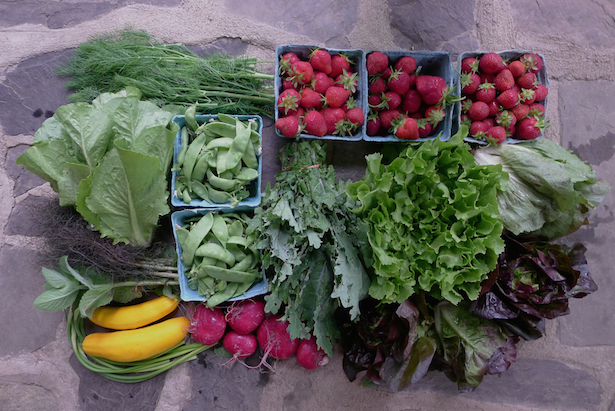
Harvest #4 (Week B) should include strawberries, 'mini' lettuces, romaine lettuce, kale, endive, escarole, radicchio, garlic scapes, summer squash, Italian dandelion, Swiss chard, basil, dill, cilantro, parsley, hakurei turnips, scarlet queen turnips, and kohlrabi. Some items will be a choice. U-pick should include snow peas, strawberries, and perennial herbs.

Notes From The Field
At Least Last Week Was Beautiful
By Derek McGeehan
At Least Last Week Was Beautiful
By Derek McGeehan
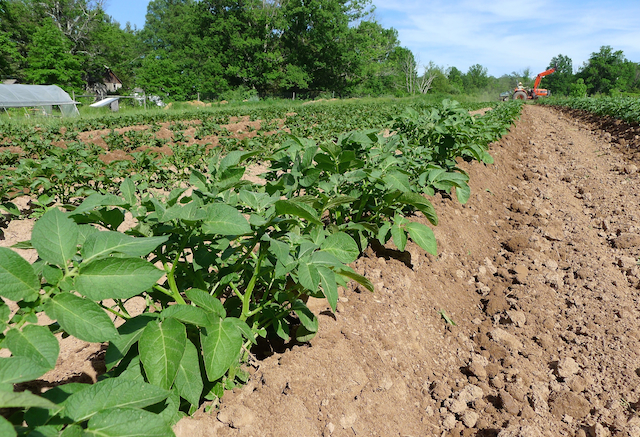
Dry soil and hilled potatoes.
The fourth week of the Main Season CSA is here. We're right in the middle of the strawberry and pea harvest, one of the best times of the eating year. Strawberries had perfect growing conditions last week and their taste today (before the rain) was simply incredible. With good weather the berries should last another couple of weeks. Peas should continue for another 2-4 weeks. We're harvesting the first planting, snow peas, with two more plantings of snap peas each spaced two weeks apart to hopefully spread out the harvest as much as possible. As peas taper off snap beans will come in so there'll be a smooth legume transition. Following strawberries will be: raspberries, blackberries, watermelon, and cantaloupe.
The fortunately gorgeous weather last week was perfect for crops and farmers. Crops grew quickly under seven days of sun. Tomato plants added a literal inch of growth daily. Farmers spent more than the average amount of weekly work hours getting caught up on tasks as well as proceeding with the typical weekly and seasonal jobs. We progressed through the first round of tomato trellising, pruning all plants to one or two leading vines, clipping each one either to a wire supported by 7' t-posts or twine suspended from wires. Two thousand out of three thousand sweet potato slips were planted (one thousand were lost by UPS but will be planted this coming week). Ten-thousand feet of potatoes were hilled twice which will provide more room for the potatoes to grow. Many crops were transplanted including lettuce, dill, cilantro, watermelon, sunflowers, yellow wax beans, and scallions. The entire onion patch was weeded with help from multiple workshifts. We're already thinking about fall even though summer isn't here: we seeded cabbage and Brussels sprouts. Next week we seed broccoli and cauliflower.
Thank you mama nature for giving us a good week for good work.
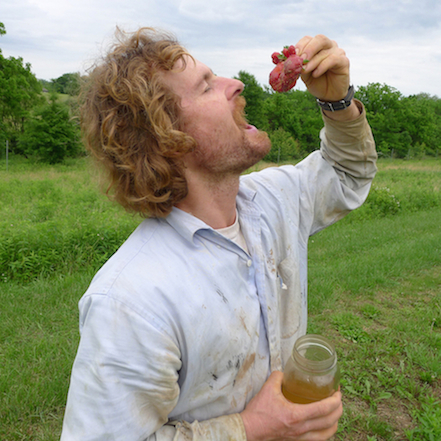
One of the largest strawberries I've ever seen had to be devoured immediately.

Workshifts for Week of 6/11/18
by Dana Hunting
by Dana Hunting
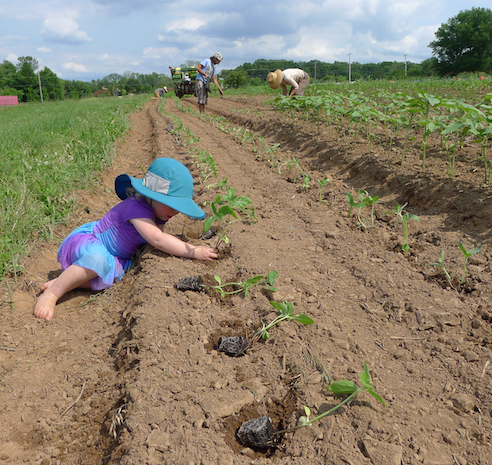
Transplanting another round of sunflowers for the u-pick cut flower patch.
Workshifts scheduled for this week:
- Tuesday 6/12 9-11am
- Tuesday 6/12 6-8pm
- Wednesday 6/13 10am-12noon
- Wednesday 6/13 6-8pm
- Friday 6/15 10am-12noon
- Sunday 6/17 9-11am
Workshift sign-up instructions may be found here.
Workshifts typically meet under the large red maple just outside of the pick up room. Please wear appropriate clothes and footwear for working outside and bring your own gloves and water.
Thank you!

How I Enjoyed My Harvest
Peas and Greens
By Linda Dansbury
Peas and Greens
By Linda Dansbury
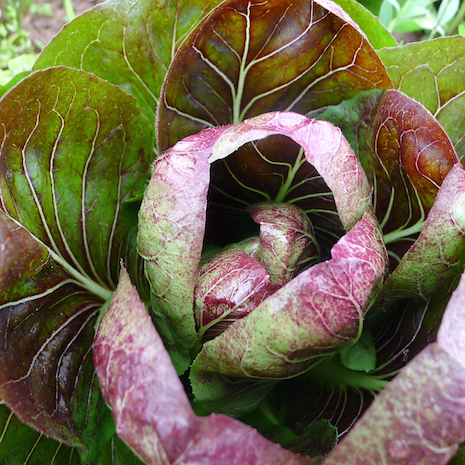
Radicchio - good for digestion and good-looking.
When I first joined Anchor Run (many years ago), I was overwhelmed this time of year with all the greens. I couldn't figure out how to use them all. Now, I get them all out and throw a little of each in salads nearly every night; the variety boosts flavor, texture and nutrients. We add greens to soups and stews that don't even call for them. We use lettuce leaves and tender chard leaves for Asian chicken, pork and shrimp wraps. How do you use your harvest? Please let me know at lindadansbury@comcast.net
Peas, scallions, parsley - made a very simple saute to go with grilled chicken. Just melted a combo of butter and olive oil, tossed in a roughly chopped scallion and sauteed until a little tender. Added peas and sauteed for just 2 minutes - you want the peas to be crunchy. Removed from heat and squeezed a bit of lemon juice and added salt, pepper and chopped parsley. It was fast, simple and delicious.
Turnips, kohlrabi, green garlic, peas - Made the Radishes with Goat Cheese Dip I described in last week's newsletter but instead of chives, I used a bit of green garlic. We had it as a nutritious and delicious appetizer.
Beets, romaine lettuce, green garlic - Roasted beets, grilled romaine, and made a Citrus Caesar Vinaigrette. Typically we have a salad of either one or the other, but decided to add some sliced beets in as well and it was really yummy.
I hope you are enjoying the bountiful harvest.

Storing Herbs
By Linda Dansbury
By Linda Dansbury
We are receiving fresh cut herbs in the pick up room these days and when you get home, you may be wondering how to best store them. You may have also found that your basil has black spots on it when you take it out of the fridge 2 days after receiving it. Basil is very susceptible to cold temperatures. The best way to store it is to trim the stems and place in a glass of water and keep it on your kitchen counter (like cut flowers). Change the water at least every other day. Dill, cilantro and parsley will do well stored with a damp paper towel in a bag in the fridge or in a glass of water (Derek and Dana have had good storage simply putting these 3 in a plastic bag in fridge but consistently eat the herbs within a few days). Most perennial herbs you cut from the herb garden will do best in a glass of water on the counter.
Truth be told, whenever I pick herbs from my garden, including perennials such as thyme, rosemary and chives, I place whatever I don't use at that time into a glass of water on the counter. The other benefit of herbs being right where you are cooking is you think of using them more often and herbs are the healthiest way of adding flavor to your dishes!

U-pick Tips
By Linda Dansbury
By Linda Dansbury
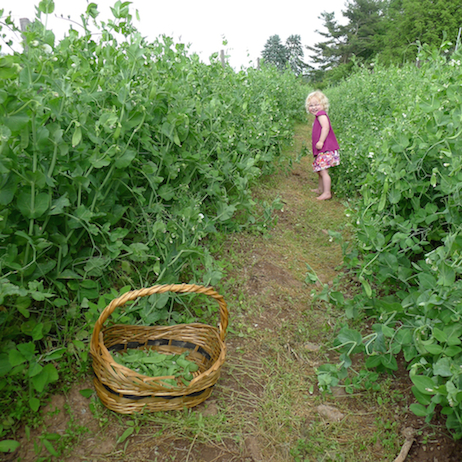
The u-pick pea patch is looking very healthy this year.
The U-Pick season has begun and I hope you are taking advantage of it. In all the years I have been fortunate to be an Anchor Run member (since the second year of its existence), the peas have never looked better - peas do not like hot temps, and especially don't like high temps followed by heavy downpours. The plants are lush, and filled with peas ready for the picking. Please use 2 hands when picking - hold the pea to be picked with one hand and the stem with the other and gently pull pea from plant. Trying to do it with one hand may result in breaking the stem or pulling it down from the trellis. After picking your allotment, put your peas in a plastic container for storage in the fridge. Leaving them in the u-pick container will result in wilted peas.
The strawberries are peaking, so get yours while you can - this is one of the most loved crops of the season, and even though Derek and Dana picked out varieties to try and spread the ripening over a period of several weeks, the berries didn't get the message. Like with the peas, use 2 hands to pick berries. Berries don't last long at my house - I keep them in the u-pick container to allow moisture to escape. They will start to "wilt" after a few days if left uncovered so if you won't be eating them right away, use a large plastic container, put a thin cloth or paper towels on the bottom to absorb any water, gently place berries in container and put the lid on it. Do not wash/rinse berries until right before eating them or you will have rotten berries (or skip this step altogether since they're completely organic).
Other tips:
Wear comfy, sturdy shoes, a large hat and sunglasses. Protect your skin with long sleeves, pants or wear sun screen. Bring your bags to the farm along with scissors/clippers. Be considerate of other members coming in behind you by picking only your allotment and being gentle with the crops.
Wear comfy, sturdy shoes, a large hat and sunglasses. Protect your skin with long sleeves, pants or wear sun screen. Bring your bags to the farm along with scissors/clippers. Be considerate of other members coming in behind you by picking only your allotment and being gentle with the crops.
Please bring back or reuse the U-pick containers each week.
Thank you and enjoy the harvest!


